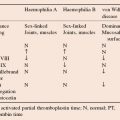Autoimmune haemolytic anaemia
This is caused by autoantibodies against the red cell membrane. It is divided into warm and cold antibody types and each may be idiopathic or secondary to other diseases (see Table 13.1).
Warm autoimmune haemolytic anaemia
Antibody, typically IgG, has maximum activity at 37°C (Table 15.1).
Table 15.1 Autoimmune haemolytic anaemia. Comparison of warm and cold antibodies
| Warm | Cold | |
|---|---|---|
| Class | IgG | IgM |
| Specificity | None or Rh | I (or i) |
| Optimal temperature of action | 37°C | 4°C |
| DAT | IgG or IgG + C3d | C3d |
| RBC destruction | Spleen or RES generally | RES generally |
| Associated diseases | CLL, SLE | Lymphoma, infectious mononucleosis |
CLL, chronic lymphocytic leukaemia; DAT, direct antiglobulin test; Ig, immunoglobulin; RBC, red blood cell; RES, reticuloendothelial system; SLE, systemic lupus erythematosus.
Clinical and laboratory features
Stay updated, free articles. Join our Telegram channel

Full access? Get Clinical Tree




